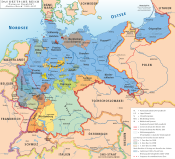|
Free State of Mecklenburg-Strelitz
The Free State of Mecklenburg-Strelitz (German: Freistaat Mecklenburg-Strelitz) was a state of the Weimar Republic established in 1918 following the German Revolution which had overthrown the Grand Duchy of Mecklenburg-Strelitz. The state lasted until the Nazi Party (NSDAP) came to power in Germany and merged the state with the neighbouring Free State of Mecklenburg-Schwerin to form a united state of Mecklenburg on 1 January, 1934. GovernmentThe state parliament consisted of a landtag of 35 members, elected for a term of four years by universal suffrage. The state administration, headed by a Minister of State was responsible to the landtag and could be removed by a vote of no confidence.[1] For most of the Weimar period, the governments were headed by either a Social Democrat or a Nationalist. However, following the Nazi seizure of power at the national level, they enacted the "Second Law on the Coordination of the States with the Reich" which established more direct control over the states by means of the new powerful position of Reichsstatthalter (Reich Governor). Friedrich Hildebrandt was installed in this post on 26 May 1933.[2] He immediately moved to take full control of the state apparatus by the appointment of a fellow-Nazi, Fritz Stichtenoth, as Minister of State on 29 May 1933.[3] By the end of the year, Hildebrandt, who was also Reichsstatthalter of the larger neighboring Free State of Mecklenburg-Schwerin, moved to consolidate his domains and merged the two states into a new united state of Mecklenburg, effective 1 January 1934.[2] And with that, the brief fifteen-year existence of the Free State of Mecklenburg-Strelitz passed into history. Rulers of Mecklenburg-StrelitzChairmen of the State Ministry of Mecklenburg-Strelitz, 1918–1919
Minister-Presidents of Mecklenburg-Strelitz, 1919–1933
ReichsstatthalterSee alsoReferences
External links
|
||||||||||||||||||||||||||||||||||||||||



